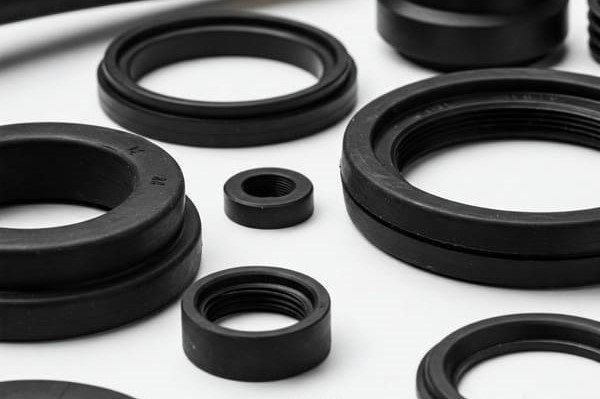Materials of Excellence
Crafting with the Best in the Business
At Julong Rubber, we prioritize using the finest materials to ensure the durability, efficiency, and performance of every product. Explore the various high-quality materials that form the foundation of our premium rubber components.
Acrylate Rubber (ACM)
Exceptional Resistance to Heat and Oil
ACM rubbers are known for their excellent resistance to both heat and oil. They function well under continuous heat, making them especially valuable for automotive transmission applications. However, they are not recommended for applications involving exposure to water or high humidity.

Acrylate Rubber (ACM):Selection Guide
Acrylate Rubber (ACM) is an advanced synthetic elastomer known for its exceptional resistance to heat, oil, and oxidation. As a key material in automotive and industrial applications, ACM plays a vital role in ensuring durability and performance under high-temperature conditions. In this comprehensive guide, I’ll walk you through ACM’s types, advantages, applications, and technical comparisons to help B2B procurement professionals make informed decisions.
What is Acrylate Rubber (ACM)?
Acrylate Rubber (ACM) is a synthetic rubber based on acrylic acid esters. It is classified as a specialty rubber designed for applications requiring high resistance to heat, oils, and automatic transmission fluids.
ACM rubber offers excellent heat resistance, typically ranging from -20°C to +150°C (short-term up to +180°C), making it ideal for high-temperature environments.
What is the Chemical Composition of ACM?
ACM is composed primarily of alkyl acrylate monomers. It contains polar carboxyl groups that enhance its oil and oxidation resistance. Common monomers include ethyl acrylate, butyl acrylate, and methoxyethyl acrylate. These structural components offer high thermal stability and resistance to oxygen and ozone.
What is the Curing Agent in ACM Rubber?
ACM rubber is typically cured using diamine, amine, or peroxide-based curing systems. The selection of the curing agent directly impacts the final mechanical properties, compression set resistance, and heat aging performance of ACM parts. Peroxide curing enhances heat resistance, while amine-based curing improves compression set performance.
Types of Acrylate Rubber (ACM)
| Type | Monomer Composition | Key Features | Typical Applications |
|---|---|---|---|
| Standard ACM | Ethyl Acrylate | High oil and heat resistance, excellent compression set | Seals, gaskets, O-rings |
| Carboxylated ACM | Carboxyl-modified acrylates | Improved adhesion to metals, better abrasion resistance | Oil seals, bonded seals |
What are the Advantages and Disadvantages of Acrylate Rubber (ACM)?
✔️ Advantages
- ✅ Excellent heat resistance (up to 150°C continuous, 180°C short-term)
- ✅ Superior oil and ATF resistance
- ✅ Good ozone and oxidation resistance
- ✅ Low permeability to gases
❌ Disadvantages
- ❌ Poor resistance to moisture and hydrolysis
- ❌ Limited low-temperature flexibility (-20°C)
- ❌ Not resistant to acids, bases, or brake fluids
🔧 Advantages vs Disadvantages Table
| Feature | Advantages | Disadvantages |
|---|---|---|
| Temperature Resistance | Excellent up to 150°C | Poor flexibility below -20°C |
| Oil and Fluid Resistance | Outstanding for ATF and engine oils | Poor resistance to polar fluids like brake fluids |
| Ozone/Weathering Resistance | Good | Not suitable for humid environments (hydrolysis risk) |
What is Acrylate Rubber (ACM) Used For?
ACM rubber is extensively used in applications requiring high heat and oil resistance, particularly in automotive powertrain systems and industrial machinery.

🚗 Automotive Industry
- ✅ Applications: Transmission seals, valve stem seals, turbocharger hoses
- ✅ Benefits: Maintains performance in high-temperature oil environments, reduces maintenance due to longer seal life
🏭 Industrial Equipment
- ✅ Applications: Hydraulic hoses, oil seals, pump diaphragms
- ✅ Benefits: Resistant to oils and fuels, ensuring longer service intervals in hydraulic systems
🔧 ACM Industry Applications Performance Table
| Industry | Temperature Range | Oil/Fluid Resistance | Durability |
|---|---|---|---|
| Automotive | -20°C to +150°C | Excellent for engine oils/ATF | High |
| Industrial Machinery | -20°C to +150°C | Excellent for hydraulic fluids | High |
What is the Difference Between ACM and AEM Rubber?
- ✅ ACM: Superior heat resistance (up to 150°C), excellent oil resistance, limited low-temperature flexibility
- ✅ AEM (Ethylene Acrylic Rubber): Better low-temperature flexibility (-40°C), good oil resistance, lower upper temperature limit (up to 135°C)
🔧 ACM vs AEM Comparison Table
| Feature | ACM | AEM |
|---|---|---|
| Temperature Range | -20°C to +150°C | -40°C to +135°C |
| Oil Resistance | Excellent | Good |
| Low-Temperature Flexibility | Limited | Excellent |
Is ACM Rubber Better Than NBR Rubber?
ACM rubber offers superior heat and oil resistance compared to Nitrile (NBR) rubber. However, NBR provides better low-temperature flexibility and is more cost-effective.
🔧 ACM vs NBR Comparison Table
| Feature | ACM | NBR |
|---|---|---|
| Temperature Range | -20°C to +150°C | -30°C to +100°C |
| Oil Resistance | Excellent (ATF and engine oils) | Good (mineral oils) |
| Cost | Higher | Lower |
How to Choose Acrylate Rubber (ACM)?
🔍 Step 1: Define the Application Requirements
- ✅ Operating temperature (-20°C to +150°C)
- ✅ Oil and ATF exposure conditions
- ✅ Mechanical stress and abrasion requirements
🔍 Step 2: Select the Correct ACM Type
| ACM Type | Key Properties | Typical Applications |
|---|---|---|
| Standard ACM | Heat and oil resistant | Automotive seals, gaskets |
| Carboxylated ACM | Improved adhesion and abrasion resistance | Bonded oil seals |
🔍 Step 3: Ensure Compliance and Quality Standards
- ✅ ISO 9001: Certified manufacturing
- ✅ RoHS and REACH compliance
- ✅ Industry-specific standards (automotive, aerospace)
📞 Get Expert Advice on ACM Rubber Selection!
At Julong Rubber, we provide custom ACM seals and gaskets designed for automotive and industrial applications. Our engineering team ensures optimal material selection based on your project requirements.
- ✅ ISO 9001 certified production
- ✅ Free technical consultation and samples
- ✅ Competitive B2B pricing with global delivery
📧 Contact Kelly at Julong Rubber Today!
Email: info@rubberandseal.com
Website: www.rubberandseal.com
🔗 Explore Other Rubber Materials
Custom Rubber Parts with Easy
At Julong Rubber, We turn complex Into Simple! Follow the following 3 steps to start today!

Tell Us What You Need
Tell us as specific as possible of your needs, provide the drawing, reference picture and share your idea.

Get Solution & Quote
We will work on the best solution according to your requirements and drawing, the specific quote will be provided within 24 hours.

Approve for Mass Production
We will start mass production after getting your approval and deposit, and we will handle the shipment.

Get A Free Quote
Contact us to get a free quote and more expertise about custom rubber parts. Your project will meet the right solution at Julong Rubber.
Email:info@rubberandseal.com




